 |
 |
 |
 |
 |
 |
| |
 |
|
 |
 |
 |
  |
  |
 |
 |
 |
 |
|
 |
 |
Gio Ponti
[Giovanni Ponti] |
|
* Milan [Milano], Italy, 18 November 1891 |
|
+ Milan [Milano], Italy, 16 September 1979 |
| nationality:
italian |
|
 |
|
|
|
|
|
 |
 |
 |
ESSAYS AND ARTICLES |
 |
|
 |
|
 |
 |
 |
| |
 |
Gio Ponti. A life for Housing
Graziella Roccella
Gio Ponti is an independent personality who overpasses the boundaries of space and time, whose extensive work has explored every horizon of meaning of the concept of housing, resulting extremely updated still now. Equipped with an endless and sincere passion for architecture, Ponti faces any theme without any hierarchical distinction, working with the same intensity and quality of results in the fields of architecture, painting, design, furniture and communication with excursions in theater and applied arts.
Gio Ponti is a complete artist and a great cultural animator who works for nearly sixty years, getting to a synthesis between formal language and the apparent dialectic concepts of complexity and linearity, classical and contemporary. His compositional process is complex and goes under a "secret structure", shared only with his staff. More complex is the genesis of the project so easier and spontaneous is the result. So he proceeds, all life long, from heavy to light, from simple to complex and sometimes for a game of lightness and detachment, it reverses the route, finding enemies among the critics who are unable to decipherate him. For his great autonomy, Ponti should be quoted among the protagonists on the scene of contemporary architecture. Instead, the disbalance that afflicts the Italian architectural critic,either for the classic or the rational, risks to relegate him to a secondary role.
Ponti’s classicity, as a non-programmatic filter for his cultural background, is supported by a lively compositional ability to operate original choices in formal and decorative aspects. "Ponti is a modern case of a ancient architect", this is definition by his daughter Lisa Licitra Ponti. The classicism works in him at an unconsciouss level since World War I, when he spent entire nights in the abandoned Venetian villas by Andrea Palladio, during resting time in-between military actions. Ponti’s classical approach seems to derive from experiencing those buildings’ spaces with closed eyes, thus developping a new sensibility to the housign theme.
"Who are you dad’s masters?" he asks to his little children; "Serlio, Palladio and Vitruvius” is the choral answer from Lisa and Giovanna as it was a nursery rhyme. This classical approach, also due to the academic circle of Piero Portaluppi and Giovanni Muzio, is mostly evident in his early works, such as via Randaccio House in Milan, built with Emilio Lancia, where however, there is already a sense for building new ethical modern interiors functional, and practical. Ponti proves a strong commitment in supporting Modernity: in order to spread modern culture he often compares the house to a car and asks: why people claim the ultimate technology in transportation and instead is satisfied by antiquated houses? These principles are applied in so-called Typical Houses (Case Tipiche) in Milan, all with different names: Domus Julia, Domus Aurelia, Domus Serena, just to name a few.
Since the Thirties, he teaches at the Polytechnic of Milan and is the founder and director of Domus, an international magazine, unique on the Italian press scene for his cross-cutting interest in regard to architecture, design, art and applied arts. Ponti is Editor from 1928 until his death, and he works with longtime collaborators such as his daughter Lisa, Enrichetta Ritter, Mario Tedeschi and, sometimes he even invites friends to write for Domus, including Bernard Rudofsky, Charles Eames, Ettore Sottsass. Only for a short period, from 1941 to 1947, Ponti abandons Domus to found the magazine "Style", due to some problems with the publisher Gianni Mazzocchi. However once he solves the misunderstanding, after the war he returns to Domus, promoting relationships between artists and industry and he porves to be a key figure for the birth and dissemination of industrial design in Italy. At a time when, internationally, the foreign industries producing household goods are highly competitive, Ponti presses Italy to start its own modern production, based on the transfer and preservation of the precious heritage of techniques from local workers to young artists. He himself draws hundreds of objects for the house, for the glass industry and for the furniture, fabric and ceramic ones. With many new collections for Richard-Ginori, Fontana, Artemis and Venini, he renews the Italian production in the fields of ceramics and glass thus contributing to the spread of the Italian design in the world. In the field of interior design, thousands of drawings of chairs, tables, sofas, furniture, for Cassina, Frau, Ideal Standard, Walter Ponti, export the craftsmanship and the Italian industrial production abroad. Ponti designs dishes, cutlery, curtains and fabrics. In the Forties he is also dedicates some attention to costumes for Teatro La Scala in Milan, prototypes for sewing machines (Borletti 1948), a coffee machine, (La Pavoni, 1948), and even in 1953 the proposal for a car shell called Diamond (Diamante). During the Fifties Ponti deserves international consecration with the construction of some houses for some enlightened clients and for Pirelli Tower. He gets also many foreign commissions such as the government offices in the important program of Baghdad in 1955. Over the Sixties, he works in Pakistan (Pakistan House Hotel, 1962), Hong Kong (facade of department stores Shui-Hing, 1963), for the Ministries of Islamabad in 1964, in Eindhoven, where he redesigns the front facade of the Bijenkorf General Store in 1967, in addition to unrealized projects of residential towers in Montreal (1961) and the Cultural Center A. Bruckner in Linz in 1963. In 1968, as a culmination of this happy period, and a whole career, the Royal College of Art in London awards him an honorary degree. Ponti also receives the Gold Medal from the French Academy of Architecture.
The Seventies are the last decade in which Ponti operates: we can consider its latest architecture as expressions of Felicitas et Facilitas: from the Cathedral of Taranto to the Denver Art Museum he accomplishes the process of dematerialization as the climax of a life dedicated to housing in all its forms and expressions.
December 2010 |
|
 |
 |
 |
BUILDINGS |
 |
|
 |
|
 |
 |
 |
|
|
 |
|
|
  United States
United States
» Denver |
|
|
|
|
 |
|
|
|
 |
|
|
  Italy [Italia]
Italy [Italia]
» Milan [Milano] |
|
|
|
|
 |
|
|
  Venezuela
Venezuela
» Caracas |
|
|
|
|
 |
|
|
  Italy [Italia]
Italy [Italia]
» Milan [Milano] |
|
|
|
|
 |
|
|
  Italy [Italia]
Italy [Italia]
» Milan [Milano] |
|
|
|
|
 |
|
|
  Italy [Italia]
Italy [Italia]
» Rome [Roma] |
|
|
|
|
 |
|
|
  Italy [Italia]
Italy [Italia]
» Milan [Milano] |
|
|
|
|
 |
|
|
  Italy [Italia]
Italy [Italia]
» Milan [Milano] |
|
|
 |
 |
 |
 |
BIBLIOGRAPHY |
 |
|
|
 |
|
 |
 |
 |
WRITINGS
BY THE ARCHITECT |
 |
|
|
 |
| Gio Ponti, ""Espressione" dell'edificio Pirelli in costruzione a Milano/"Expression" of the Pirelli building now under construction in Milan", Casabella 733, maggio/may 2005, pp. 68-73 (68-77), 97-98 |
|
|
| Gio Ponti, "La religione, il sacro", Domus 497, aprile/april 1971, pp. 15-21 (11-23) |
|
|
| Gio Ponti, "America: the happy Denver Museum", Domus 485, aprile/april 1970, p. 36 |
|
|
| Gio Ponti, "Chiesa dell'autostrada del Sole, vicino a Firenze", Domus 413, aprile/april 1964, pp. 38-40 |
|
|
| Gio Ponti, "Andiamo a Marsiglia?", Domus 235, aprile/april 1949, p. XI |
|
|
|
 |
 |
 |
WRITINGS
ABOUT THE ARCHITECT |
 |
|
|
 |
| Joseph Rykwert, Gio Ponti: A Critical Consideration, Divisare, Roma 2020 |
|
|
 Graziella Roccella, Gio Ponti 1891-1979. Master of lightness, Taschen, Köln 2009 Graziella Roccella, Gio Ponti 1891-1979. Master of lightness, Taschen, Köln 2009
tr. fr.: Gio Ponti 1891-1979. La légèreté de la matière, Taschen, Köln 2009
tr. ger.: Gio Ponti 1891-1979. La Meister der Leichtigkeit, Taschen, Köln 2009
tr. it.: Gio Ponti 1891-1979. Maestro della leggerezza, Taschen, Köln 2009
tr. sp.: Gio Ponti 1891-1979. Maestro de la levedad, Taschen, Köln 2009 |
|
|
 Paolo Piccione, Gio Ponti. Le Navi. Il progetto degli interni navali 1948-1953, Idea Books, Viareggio 2007 Paolo Piccione, Gio Ponti. Le Navi. Il progetto degli interni navali 1948-1953, Idea Books, Viareggio 2007 |
|
|
| Maria Antonietta Crippa, Carlo Capponi (ed.), Gio Ponti e l'architettura sacra. Finestre aperte sulla natura, sul mistero, su Dio, Silvana, 2006 |
|
|
| Massimo Martignoni, Gio Ponti. Gli anni di Stile. 1941-1947, Abitare Segesta, Milano 2002 |
|
|
| Lucia Miodini, Giò Ponti. Gli anni trenta, Electa, Milano 2000 |
|
|
 Ugo La Pietra, Gio Ponti, Rizzoli, Milano 1995 Ugo La Pietra, Gio Ponti, Rizzoli, Milano 1995 |
|
|
| Gloria Arditi, Cesare Serratto, Gio Ponti. Venti cristalli di architettura, Il Cardo, 1994 |
|
|
Lisa Licitra Ponti, Gio Ponti. L'opera, Leonardo Editore, Milano 1990
review: Claudia Conforti, Domus 720, ottobre/october 1990, p. I |
|
|
| Donatella Paterlini, "Ponti e Milano. Dalle prime opere alle facciate in ceramica", Domus 708, settembre/september 1989, "Itinerario n. 49" pp. XI-XVI |
|
|
Mario Universo, Gio Ponti designer. Padova 1936-1941, Editore Laterza, Bari 1989
review: Arturo Dell'Acqua Bellavitis, Domus 709, ottobre/october 1989, "Libri/Books", p. V |
|
|
Domus 599, ottobre/october 1979, cover
Gianni Mazzocchi, "Gio Ponti 1891-1979", Domus 599, ottobre/october 1979, p. 1
Alessandro Mendini, "Gio Ponti 1891-1979", Domus 599, ottobre/october 1979, p. 1 |
|
|
 Design Quarterly 69-70, Nathan H. Shapira, The expression of Gio Ponti, Walker Art Center, Minneapolis 1967 Design Quarterly 69-70, Nathan H. Shapira, The expression of Gio Ponti, Walker Art Center, Minneapolis 1967 |
|
 |
 |
 |
 |
THE ARCHITECT IN CINEMA |
 |
|
|
 |
|
 |
 |
 |
| Title |
 |
|
 |
|
| Directed by |
 |
|
 |
|
| Nationality |
 |
|
 |
|
| Year of production |
 |
|
 |
|
| Cast |
 |
|
 |
|
| Architect's role |
 |
|
 |
Protagonist
Molteni&C si fa promotore di un progetto inedito, il primo film documentario sul grande maestro del ‘900, interprete del design milanese, dal tilolo “Amare Gio Ponti”.
Il documentario si basa sulla ricerca di materiali storici inediti, delle fonti iconografiche dei Gio Ponti Archives e delle Teche Rai, con un’intervista a Gio Ponti nel suo studio di via Dezza, le testimonianze degli eredi e le interviste ai protagonisti di oggi. |
|
 |
 |
 |
 |
 |
 |
 |
EXHIBITIONS |
 |
|
|
 |
|
 |
 |
 |
|
|
 |
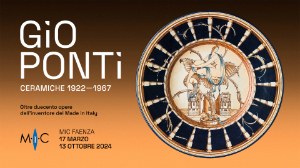 Gio Ponti. Ceramiche 1922-1967. Oltre duecento opere dell’inventore del Made in Italy Gio Ponti. Ceramiche 1922-1967. Oltre duecento opere dell’inventore del Made in Italy, Faenza (Italy), MIC Museo Internazionale della Ceramica, 17 march / 13 october 2024
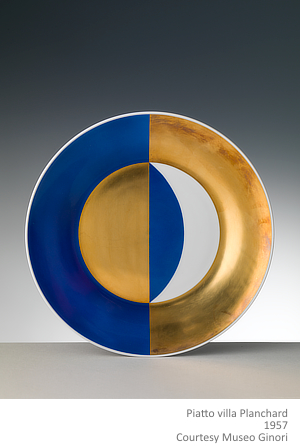 Al grande architetto, artista e designer Gio Ponti (1891-1979), promotore e divulgatore del “fare” italiano, è dedicata la prossima mostra del MIC Faenza che apre al pubblico il 17 marzo per rimanere allestita fino al 13 ottobre 2024. Al grande architetto, artista e designer Gio Ponti (1891-1979), promotore e divulgatore del “fare” italiano, è dedicata la prossima mostra del MIC Faenza che apre al pubblico il 17 marzo per rimanere allestita fino al 13 ottobre 2024.
La mostra dal titolo “Gio Ponti. Ceramiche 1922-1967”, a cura di Stefania Cretella, espone in quattordici sezioni oltre duecento opere - tra ceramiche, vetri, arredi e disegni - attraverso le quali viene analizzato, dal 1922 al 1978, il lavoro di Gio Ponti in relazione alla sua visione dell’abitare e di un nuovo vivere moderno.
“Impari le cose fatte con le mani. Nulla che non sia prima nelle mani”, questa sua emblematica citazione racchiude il suo pensiero, che fin dagli esordi recupera la tradizione classica (etrusca e romana) e il fare dell’alto artigianato artistico, adattandoli al gusto moderno. Ponti è stato una figura chiave nella definizione dello stile italiano non solo attraverso la propria attività progettuale, anche grazie alla fitta rete di relazioni con artisti, industriali e artigiani, ma soprattutto grazie alla direzione di due riviste divenute storiche del settore come “Domus” e “Stile” e alla costante partecipazione a mostre ed esposizioni.
Ponti è infatti protagonista delle Biennali di Monza, delle Triennali di Milano e di eventi internazionali come la mostra itinerante “Italy at Work. Her Renaissance in Design Today” tenutasi negli Stati Uniti tra il 1950 e il 1953, volta proprio a promuovere oltreoceano il “Made in Italy” presentando i massimi rappresentati del design e dell’alto artigianato artistico italiano.
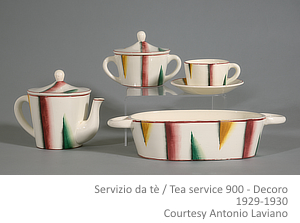 Il suo rapporto con la ceramica inizia appena laureato. Tra il 1921 e il 1922 Ponti giunge alla Richard-Ginori e comincia il rinnovamento del repertorio storico della manifattura proiettandola verso il nascente gusto déco. La mostra mette a fuoco il fondamentale contributo apportato dal nuovo direttore artistico nel corso di circa un decennio, proponendo anche confronti con designer e artisti attivi negli stessi anni presso altre manifatture italiane, evidenziando le ricadute che il modello pontiano ha avuto sul contesto contemporaneo. Il suo rapporto con la ceramica inizia appena laureato. Tra il 1921 e il 1922 Ponti giunge alla Richard-Ginori e comincia il rinnovamento del repertorio storico della manifattura proiettandola verso il nascente gusto déco. La mostra mette a fuoco il fondamentale contributo apportato dal nuovo direttore artistico nel corso di circa un decennio, proponendo anche confronti con designer e artisti attivi negli stessi anni presso altre manifatture italiane, evidenziando le ricadute che il modello pontiano ha avuto sul contesto contemporaneo.
Dai primi anni Trenta Ponti si avvale della collaborazione del giovane apprendista Giovanni Gariboldi che diventa suo assistente di fiducia e poi suo successore in casa Richard-Ginori. Terminati i rapporti con la manifattura nel 1933, Ponti torna saltuariamente a collaborare con l’azienda proponendo idee di grande estro creativo e inizia a stringere nel tempo rapporti con il mondo delle arti decorative e del design. In oltre cinquant’anni di attività collabora con Pietro Melandri e il contesto faentino (famose le cartepeste realizzate con i Dalmonte), con le Ceramiche Pozzi, Gabbianelli, Venini, Fontana Arte e Sabattini, per citare le principali aziende con cui promuove percorsi e progetti unici e straordinariamente attuali.
La cifra stilistica di Ponti è un segno senza tempo, contemporaneo, che ha stimolato dialoghi con artisti e designer della sua epoca, ma ha anche ispirato ceramisti del XXI secolo. La mostra si conclude infatti con una sezione dedicata all’eredità di Ponti e alle influenze che questa ebbe su autori quali Alessandro Mendini ed Ettore Sottsass, per giungere ai contemporanei POL Polloniato, Diego Cibelli, Bertozzi&Casoni, Andrea Salvatori. |
|
|
Il Trionfo da tavola di Gio Ponti dal Museo Ginori a Villa Necchi, Milano (Milan) [Italy], Villa Necchi Campiglio, 6 december 2023 / 28 january 2024
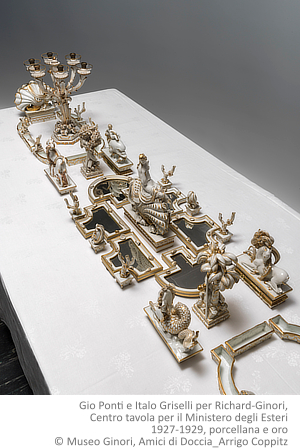 Il centro tavola, ideato da Gio Ponti con la collaborazione di Tomaso Buzzi e modellato da Italo Griselli per la Richard Ginori, nella storica Manifattura di Doccia, tra il 1927 e il 1929, è una vera e propria creazione scultorea incentrata sulla figura allegorica dell’Italia adagiata su una conchiglia e contornata da animali araldici e altri piccoli elementi in porcellana in una composizione di ben 41 elementi originali che reinterpreta un oggetto neoclassico – i sontuosi centrotavola che imitavano la spina di un circo romano - in gusto Art Déco. Il grande Trionfo da tavola, commissionato all’azienda toscana dal Ministero degli Esteri e pensato per ornare le tavole delle sedi diplomatiche in occasioni di grande rappresentanza, è esposto per la prima volta in una casa museo, in uno spazio che richiama la sua funzione originaria di decoro scenografico da tavola, ovvero nella della Sala da pranzo di Villa Necchi Campiglio. Restituire l’originario contesto agli oggetti d’arte, ma anche d’uso, è parte, del resto, della politica culturale e delle pratiche di valorizzazione del FAI nei suoi Beni, che non sono musei, ma case, come Villa Necchi, e che come case sono mantenute, allestite e raccontate, nei capolavori d’arte, appunto, così come negli arredi e negli oggetti. Il centro tavola, ideato da Gio Ponti con la collaborazione di Tomaso Buzzi e modellato da Italo Griselli per la Richard Ginori, nella storica Manifattura di Doccia, tra il 1927 e il 1929, è una vera e propria creazione scultorea incentrata sulla figura allegorica dell’Italia adagiata su una conchiglia e contornata da animali araldici e altri piccoli elementi in porcellana in una composizione di ben 41 elementi originali che reinterpreta un oggetto neoclassico – i sontuosi centrotavola che imitavano la spina di un circo romano - in gusto Art Déco. Il grande Trionfo da tavola, commissionato all’azienda toscana dal Ministero degli Esteri e pensato per ornare le tavole delle sedi diplomatiche in occasioni di grande rappresentanza, è esposto per la prima volta in una casa museo, in uno spazio che richiama la sua funzione originaria di decoro scenografico da tavola, ovvero nella della Sala da pranzo di Villa Necchi Campiglio. Restituire l’originario contesto agli oggetti d’arte, ma anche d’uso, è parte, del resto, della politica culturale e delle pratiche di valorizzazione del FAI nei suoi Beni, che non sono musei, ma case, come Villa Necchi, e che come case sono mantenute, allestite e raccontate, nei capolavori d’arte, appunto, così come negli arredi e negli oggetti.
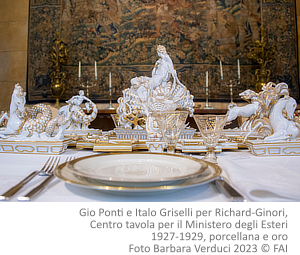 Proprio in questo contesto, peraltro, l’opera dialoga a perfezione con gli stucchi a basso rilievo sul soffitto a firma di Piero Portaluppi: motivi naturalistici, quali alberi, fiori, serpenti, aironi e motivi astrologici creano un contesto uniforme dove l’ambiente e il centrotavola trovano un accostamento ideale. Proprio in questo contesto, peraltro, l’opera dialoga a perfezione con gli stucchi a basso rilievo sul soffitto a firma di Piero Portaluppi: motivi naturalistici, quali alberi, fiori, serpenti, aironi e motivi astrologici creano un contesto uniforme dove l’ambiente e il centrotavola trovano un accostamento ideale.
Il centrotavola è inoltre una rara testimonianza della collaborazione tra Gio Ponti e Tomaso Buzzi, la cui mano è presente a Villa Necchi e in particolare nella sala da pranzo per la quale realizza due grandi consoles e che decora con grandi arazzi di Bruxelles del XVI secolo.
L’iniziativa contribuisce a celebrare i cento anni dalla prima Biennale Internazionale delle Arti Decorative svoltasi a Monza - dove la manifattura Ginori esponeva le ceramiche d’autore disegnate da Gio Ponti che proprio in quell’anno, il 1923, ne assumeva la direzione artistica – aggiungendosi alle molte altre in Italia, e specialmente a Milano, a partire dalla mostra Oro bianco. Tre secoli di porcellane Ginori in corso al Museo Poldi Pezzoli, volte a promuovere la storia e la collezione del Museo Ginori, chiuso dal 2014 in seguito al fallimento della Richard Ginori e in attesa della riapertura al pubblico.
Il FAI, in collaborazione con il Museo Ginori, intende così valorizzare, raccontandone la storia e mostrandone un’opera di rilievo, come il centrotavola, uno dei più importanti musei del Paese, oggi proprietà dello Stato italiano: una collezione unica al mondo, che conta oggetti di uso comune e preziosissime porcellane, sculture monumentali e calchi in cera e gesso, e custodisce un fondo di oltre 400 opere disegnate da Gio Ponti. Nell’occasione sarà valorizzata anche la collezione di ceramiche di Villa Necchi Campiglio, alcune delle quali firmate da Gio Ponti e prodotte dalla Richard Ginori. |
|
|
| A tavola con Gio Ponti. Gli angeli apparecchiano, Maglie (Italy), Museo Civico di Paleontologia e Paletnologia di Maglie, 1 august / 30 september 2022 |
|
|
| Domus Aurea. Martino Gamper, Francesco Vezzoli e le ceramiche di Gió Ponti, Prato (Italy), Centro Pecci, 5 april / 30 august 2020 |
|
|
 Gio Ponti. Amare l'Architettura, Roma, MAXXI Museo nazionale delle arti del XXI secolo, 27 november 2019 / Gio Ponti. Amare l'Architettura, Roma, MAXXI Museo nazionale delle arti del XXI secolo, 27 november 2019 / 13 april 2020 27 september 2020
Architect, designer, art director, writer, poet and critic, Gio Ponti was an allround artist who traversed much of the 20th century, profoundly influencing the taste of his time, responding to its most significant demands and anticipating many of the themes of contemporary architecture.
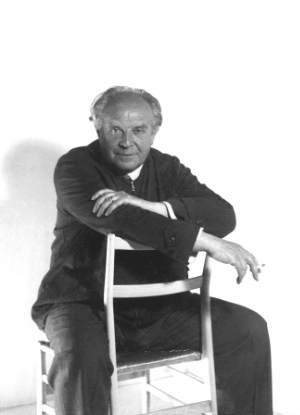 40 years on from his passing, MAXXI, the National Museum of XXI Century Arts, is devoting a major retrospective to this exceptional figure. The exhibition examines and presents his multi-faceted career, starting with an account of his architecture, a unique and original synthesis of tradition and modernity, history and progress, elite culture and quotidian existence.
The exhibition title, GIO PONTI. Amare l’architettura (Loving architecture) echoes that of his best-known book, Amate l’architettura (In praise of architecture). Curated by Maristella Casciato (Senior curator of Architectural Collections at the Getty Research Institute in Los Angeles) and Fulvio Irace (architecture critic and historian) with Margherita Guccione (Director, MAXXI Architettura), Salvatore Licitra (Gio Ponti Archives, Director) and Francesca Zanella (CSAC, President), the show will be hosted in MAXXI’s stunning Gallery 5 from 27 November 2019 to 13 April 2020 and has been produced by MAXXI in collaboration with CSAC - Centro studi e archivio della communicazione of the University of Parma, which conserves Gio Ponti’s professional archive, and the Gio Ponti Archives.
 For Giovanna Melandri, President of the Fondazione MAXXI, “Celebrating the greatness of Gio Ponti signifies immersing ourselves in a legacy that is peerless in terms of versatility, talent and application. Private buildings and public commissions, companies and places of study, objects of everyday use, office and naval furnishings, cathedrals and museums alternate within research that was never dogmatic or ideological, in which there was dialogue between classicism and modernity, the natural landscape and the urban horizon, the social vocation of space and the safeguarding of beauty.” As Margherita Guccione, Director of MAXXI Architettura says, “Neither classical nor modern, the work of Gio Ponti was unique in the history of Italian 20th century architecture, a century the architect spanned almost in its entirety, ranging from the design of objects of everyday use to the invention of spatial configurations for the modern home and the creation of complex projects embedded within the urban context, maintaining architecture, setting and saving grace of our lives, as the fixed core of his research.
The exhibition is the fruit of painstaking research that has aimed to update our understanding of the figure of Ponti the architect, highlighting a number of the guiding issues underlying his long career and his extraordinary ability to foreshadow the spaces and concepts of contemporary architectural practice. His aspiration towards verticality and lightness through the dematerialization of facades, his conception of a green city in which nature returns to playing a key role in the agenda of planning and architecture, as well as designing flexible domestic spaces, capable of adapting to the demands of their users, are without doubt themes that, over half a century ago, anticipated with unique clarity the concerns of the present-day. |
|
|
| Tutto Ponti, Gio Ponti Archi-Designer, Paris, MAD Musée des Arts Décoratifs, 19 october 2018 / 5 may 2019 |
|
|
| Domus 90. Gio Ponti, Milano, Galleria Carla Sozzani, 15 april / 6 may 2018 |
|
|
Vivere alla Ponti. Esperimenti di vita domestica e architetture per l'abitare e il lavoro
Venezia, Palazzo Corner Spinelli, 27 august / 28 september 2012
Roma, sede Edison di Roma, 2 december 2014 / 9 january 2015
Como (Italy), Ridotto del Teatro Sociale,13 december 2019 / 6 january 2020 |
|
|
| Lina & Gio: The Last Humanists, London, Architectural Association Gallery, 25 february / 24 march 2012 |
|
|
Gio Ponti. Il fascino della ceramica
Milano, Grattacielo Pirelli, 6 may / 31 july 2011
Roma, Casino dei Principi di Villa Torlonia, 22 october 2011 / 8 january 2012 |
|
|
| Espressioni di Gio Ponti, Milano, Triennale di Milano, 6 may / 4 september 2011 |
|
|
| Giò Ponti: un architetto italiano in America Latina, Roma, IILA (istituto Italo-Latino Americano), 4/8 october 2010 |
|
|
| Gio Ponti in Casa Palladio, Fratta Polesine (RV), La Badoera (Villa Badoer), 21 february/28 june 2009 |
|
|
| Gio Ponti Designer, Calenzano (FI), Fondazione Anna Querci per il Design, 15/20 may 2007 |
|
|
Gio Ponti: a world
London, London Design Museum, 3 may/6 october 2002
Milano, Triennale, 15 february/22 april 2003 |
|
 |
  |
 |
|
|